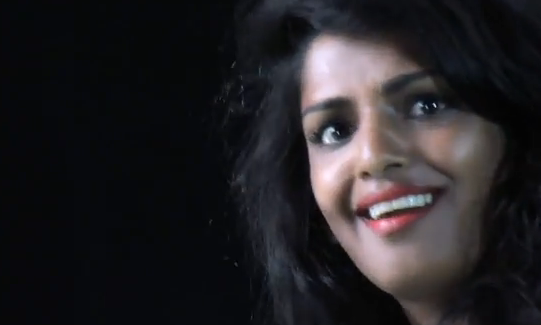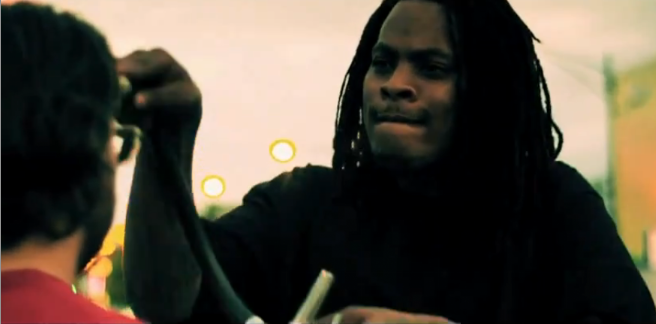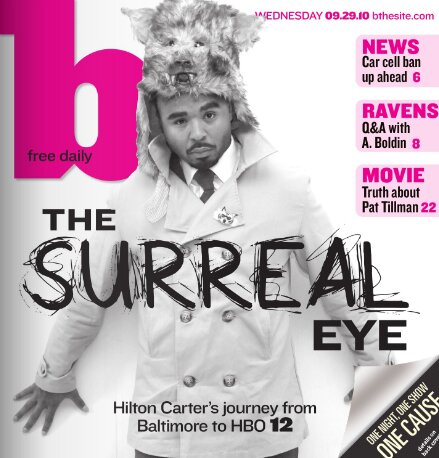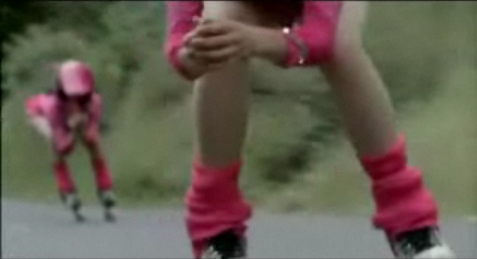Right after the latest episode of Jersey Shore, Kanye West and director Marco Brambilla’s video/commerical/art project for “Power” premiered in all its epic, underwhelming glory. Basically, “Power” is a less crowded version of Brambilla’s 2008 hotel installation “Civilization,” and like that digital-imagery video collage, “Power” is schticky but awesome. All the “Pop-art” stuff Kanye’s been yammering on about for a few years now? Here’s the apotheosis–for better and worse.
Responses to the video though, have been pretty cold-shouldered. Sean Fennessey–a guy who’s been wrestling with Kanye’s work since the start—thinks the whole thing’s undercooked. Some broad for The Atlantic Monthly called it “a mesmerizing screensaver.”
There’s a bit of a bias against digital art going on here, but the responses also sent me back to undergraduate literature classes, where shiny, grandiose works that wrestled with universals like vanity and the fragility of life got laughed-off in favor of immediate, “what’s it’s like to live at the end of the millennium” type works. Sure this clip is big and ponderous, but it doesn’t shout-out its importance really. It’s sincere and knowing and Kanye’s laughing a bit about the fact that he got this weird-ass thing on television and all over the internet.
Kanye has also been into cultivating memes lately. Whether it’s his blog or award show pranks or outre videos, he makes conversation-stimulating, argument-starting chunks of sound and image to accompany his actually fairly subtle music. He cleverly balances the demands of the music-marketing game of the 2000s with a rarefied, creative spirit. So, he drums-up controversy with a Spike Jonze-directed single-take video that shows his death by shovel and video girl. Or he makes a fairly insane, grabbing from all directions, Neo-classical digital art project and gets it on MTV after the fucking Jersey Shore.
Think about that as the context for “Power.” Is there a more depressing, end-of-days, this-is-why-the-world-hates-us show than Jersey Shore? The Situation and Snooki consumed by their insignificant, bullshit-ass problems (which now hey, include fame!) all scored to soul-less, date-rape rave beats? No one Guido should have all that power.
The context for “Power,” coupled with its message, makes it the kind of take-back-the-night use of one’s fame that has all but disappeared from the pop landscape. Only Lady Gaga tries this hard and she fails way more often. “Power” is basically a culture-jam—rap is pretty much always a culture-jam though—in which Kanye deconstructs MTV commercials and regularly-scheduled programming and the endless, chintzy New Music Cartel stream of shit videos and shit video teasers. “Power” just doesn’t fit anywhere.
You want violence? Here’s the end of the world and dudes with swords and shit. You want video girls? Here’s a chick pouring water on herself like it’s a Nelly video only she’s upside down. You want a “conscious” portrayal of women? Check out those stalwart females to the left and right of Kanye pounding their staffs to the rhythm. And at the center of it is Kanye, wearing a chain nearly weighing him down (wasn’t this the original symbology of chains in rap, a symbol of wealth as well as a tangible reminder of the trappings of all that?), as all the decadence swirls around him, unknowingly about to lose his head. Literally.
West, grew up waiting for the premieres of Michael Jackson videos before The Simpson and wants to–no needs to–make an event video, but he’s got an aggressive, very hip-hop side that makes these videos loaded, and occasionally fraught with meaning. He’s gotta be subversive, but for the first time here, that subversiveness and its intended message aren’t weighed down by the messenger. “Power” is thematically antithetical to the egotism expected from rap but it’s style and construction oppose cheap rewards too.
The self-important slow-motion denies the speedy, histrionic editing of most videos and commercials while also reclaiming a technique that when it is employed, is used to just make, say, Young Jeezy look cool stepping out of a car. By slowing the imagery, you really soak in all the loaded, obvious stuff going on and get smashed over the head with its decadence. Director Brambilla’s technique—shoot a bunch of stunning imagery separately and then slam it all together with the aid of computers—is perfect because it gives the video an unreal, slightly “off” quality that makes it all the more unappealing. If this were staged, somehow shot live, all in one room, there would be human qualities to it, something imperfect, but as it is, each image is made “perfect” and then stacked upon another “perfect” image. It feels strange and just plain off. You get to ponder it and you get pretty creeped out.
The cut to black, a moment before the good stuff happens (Kanye gets decapitated) also seems to be an issue for some. They’re waiting for something to happen, as if the video’s not a big mess of stuff happening. Viewers want the final, epic, shocking moment—whenever I think of videos and a moment like this, I think of the moronic culmination of Jonathan Glazer’s video for UNKLE’s “Rabbit In Your Headlights”–but Kanye and Brambilla don’t give it to you because dude, that’s not the point at all.
The “anti-climactic” ending actually suggests another misread work of bold, capital-A art wrestling with fame and hubris: Sofia Coppola’s Marie Antoinette (2006). Coppola’s film ends before Marie’s infamous beheading, but the sequence of events is set-up so that her trip to the guillotine is inevitable. Like that movie, “Power” has a little too much love for its subject (in Kanye’s video: himself) to visualize the demise, but it’s also a way to reject cheap thrills. And usually, music videos, MTV, and commercials, are all about cheap thrills.
further reading/viewing:
-“Power,” Paintings, Pomposity: The Uncertain Evolution of Kanye West’s Music Videos” by Sean Fennessey for Sound Of The City
-“Subvertising” on Wikipedia
-“M.I.A. and music’s newest marketing frontier: the guerrilla web itself” by Gardner
-Buy Marco Brambilla’s Demolition Man
-“Race & Gender Devolution in ‘Flashing Lights’ Version 2″ by ME




 Sorry about the lack of updates lately, you’ll just have to jump off-site to read my rambling. Trying to get back on-track this week though. For now, there’s another installment of my “Music Video Round-Up” column, this time talking about the wonderfully nutty video for Beyonce’s “Sweet Dreams” and the whatever but kinda cool video for Yo La Tengo’s “Here to Fall” and the transformative qualities of CGI when used properly, in both.
Sorry about the lack of updates lately, you’ll just have to jump off-site to read my rambling. Trying to get back on-track this week though. For now, there’s another installment of my “Music Video Round-Up” column, this time talking about the wonderfully nutty video for Beyonce’s “Sweet Dreams” and the whatever but kinda cool video for Yo La Tengo’s “Here to Fall” and the transformative qualities of CGI when used properly, in both. So, my music video column on “The House Next Door” finally returns and I’m going to keep up a regular pace with it and not like, one every four months at the best. The first returning one is a little weird because it’s not about music videos really, but it is an interview with the film director Tony Stone who directed the absolutely amazing Viking, Black Metal movie Severed Ways. Stone and I talk about digital video, Michael Mann, metal’s appeal, and lots of other stuff. If you’ve not seen Severed Ways, please go rent it or buy it, you won’t be disappointed…
So, my music video column on “The House Next Door” finally returns and I’m going to keep up a regular pace with it and not like, one every four months at the best. The first returning one is a little weird because it’s not about music videos really, but it is an interview with the film director Tony Stone who directed the absolutely amazing Viking, Black Metal movie Severed Ways. Stone and I talk about digital video, Michael Mann, metal’s appeal, and lots of other stuff. If you’ve not seen Severed Ways, please go rent it or buy it, you won’t be disappointed… I talk about the Young Jeezy videos “My President” and “Crazy World”, as well as Killer Mike’s “Pressure” video. I’d also like to note that very quietly–a surprise in the hype-everything world of rap–that “My President” director Gabriel Hart has tacked-on a terrible, terrible intro to the video. He’s also re-edited it, and so we get less Bun B about to cry with excitement and just a general fucking-with the rhythm. I wrote my review when the original only existed and rather than re-write or qualify it, I tossed-in a few lines about the re-edit and kept my initial reading:
I talk about the Young Jeezy videos “My President” and “Crazy World”, as well as Killer Mike’s “Pressure” video. I’d also like to note that very quietly–a surprise in the hype-everything world of rap–that “My President” director Gabriel Hart has tacked-on a terrible, terrible intro to the video. He’s also re-edited it, and so we get less Bun B about to cry with excitement and just a general fucking-with the rhythm. I wrote my review when the original only existed and rather than re-write or qualify it, I tossed-in a few lines about the re-edit and kept my initial reading:
